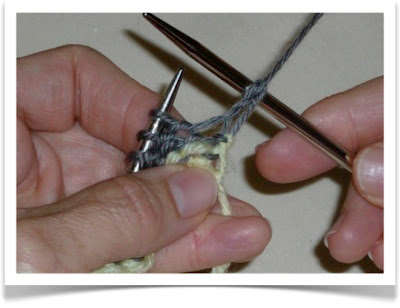This is a fun little slouch tam, with a lot going for it. The Brioche pattern in the main body not only gives texture and interest to the look of the hat, but it works up a thicker, loftier fabric. This equals greater warm!
It has only a slight slouch, for those who don't want to go too big, but are wanting somethings other than the typical toque. The green version was knit in Cascade 220 for the main colour, and Punta Yarns Mericash Thousand Colours for the multi-coloured contrast. The Cascade 220 has quite a bit of body, so the hat's slouch has only moderate drape.
However, this grey and pink version has considerably more drape in the slouch. This comes from the two incredibly soft yarns used in its construction. Pear Tree Yarn's Super Soft 8ply in Nut was used for the main yarn, and Malabrigo Worsted in Vetiver is the contrast in the Brioche portion of this hat. (NOTE: When using a yarn as soft as this for your main colour, if you have a smaller head you may want to knit the ribbing with a ½ size smaller needle.)
Besides the change it drape, the Malabrigo Worsted also gives a different look to the Brioche. Being a single ply yarn, it tends to puff in this stitch pattern, which I really love. It adds even more to the 3-dimensional quality of the Brioche. The main body of this version is sooooo soft and squishy!
But no matter what yarn you choose, the back comes together to look something like a giant carnation. And if you aren't big on colour, this pattern would make a great single colour, textured hat by knitting the whole thing in one solid coloured yarn.
One more thing to note. Although you could just use your favourite cast-on method, I introduced the Tubular Cast-on in this pattern to give this hat a cleaner, more professional looking edge. If you should choose to try out this method, you will find photo tutorials in my two previous posts, Tubular Cast-on: Part 1 and Tubular Cast-on : Part 2.
Interested in knitting this project? Here is some helpful information.
SIZE: Average Ladies [54cm-56cm (21-22")]
GAUGE: 15 sts/19 rows = 10cm (4") in 2 Colour Half Brioche Stitch on 5mm (8US) needles
MATERIALS:
- approx. 80m (90 yds) hand-dyed or multi-colouered DK or worsted weight yarn for contrast yarn in Brioche portion of hat
- approx. 90m (100 yds) worsted weight yarn for main colour yarn in ribbing and background of Brioche portion of hat
- approx. 1.5-2m (1½-2 yds) of contrasting colour waste yarn
- 4.5mm (7US) - 40cm (16 inch) circ. needle
- 5mm (8US) - 40cm (16 inch) circ.needle
- 1 set 5mm (8US) dpn
- stitch marker
This is a very versatile pattern in that by changing colours and types of yarns used, you can create any number of different looks and personalities. So have some fun with it!














